|
|
About
Us (Review - Wisconsin State Journal - Sunday,
February 14, 2010)
At Pollo Inka - Peppy Peruvian Flavors
and Exotic Tastes
Polla Inka is a Peruvian Cuisine restaurant located
on Madison's west side.
- Location: 745 N. High Point Road (corner of
Old Sauk)
- Phone: (608)833-4287
- Hours: Monday through Saturday 11 AM to 9
PM - Sunday 11 AM to 8 PM.
- Specialties: Peruvian cuisine
- Prices: Appetizers $5 to $11; soups $5 to
$13; entrees $4 to $24
- Smoking: No
- Noise level: Moderate
- Credit cards: Accepted
- Accessibility: Yes
- Reservations: Not accepted
Excellent seafood paella is just one of the many
attractions; good service and modest prices. The hyperbole
on the menu of the new Pollo Inka Peruvian restaurant can provide
great entertainment.
The claim about its rotisserie chicken: "This bird will have
you tweeting in ecstasy." They also offer "A restorative
aphrodisiac soup from the sea that will capture you with its addictive
flavor."
A potato-cheese appetizer is no less than "A gift from Peru
to the world," whereas a fried yucca appetizer promises "to
give happiness to the soul and joy to the palate."
The thing is, though, that some things on the menu of Madison's
second Peruvian restaurant live up to the florid descriptions.
The Peruvian seafood paella ($15.95) is easily the best I've ever
had, especially considering that it was served in Wisconsin in January.
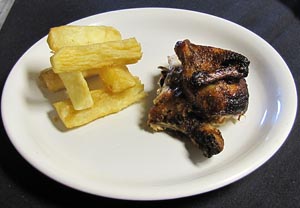 There was a big mix of seafood, all of it fresh and tender.
And then there was the rice — so often crunchy and dry in
paella — that was infused with a fish-and-white-wine consomme
with aromatic spices and zinged up with a peppery Creole sauce.
There was a big mix of seafood, all of it fresh and tender.
And then there was the rice — so often crunchy and dry in
paella — that was infused with a fish-and-white-wine consomme
with aromatic spices and zinged up with a peppery Creole sauce.
Another well-executed entree was a shredded
chicken casserole ($9.95) with succulent white and dark meat and
an interesting combination of Peruvian mirasol peppers, boiled potatoes,
Parmesan cheese, sliced hard-boiled eggs, black olives and ground
walnuts that added salty crunch.
The tilapia ($7.95), cooked in Spanish-Incan style, is another winner;
it arrived heaped with sliced onions and red peppers that were soft,
with a great balance of sweet-and-sour Creole sauce. The fork-tender
fish tasted buttery with a hint of crunch on the crust.
The roasted chicken ($4 for a quarter chicken), said to induce "tweeting
in ecstasy" on the menu, was juicy and tender, but while it
was marinated in 15 "secret" ingredients, it tasted like
any other 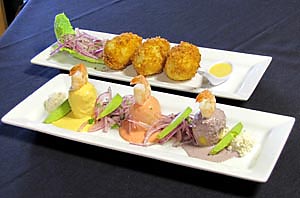 good rotisserie chicken. No tweeting, I'm afraid.
good rotisserie chicken. No tweeting, I'm afraid.
The appetizers, salads and soups are a good way to explore the intriguing
taste combos found in Peruvian food.
The most intriguing surprise was tamalito verdes ($6.95), which
was ground Peruvian corn, like a masa but bright green because it
was blended with cilantro, stuffed with shredded chicken and served
with the red onion Creole sauce.
Also on the "What on Earth is that?" list were three small,
bright gold cylinders of mashed potatoes, which took their color
from the yellow 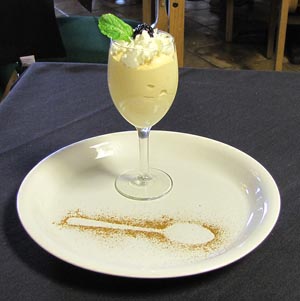 peppers they were blended with, and a crisp bite from the addition
of lemon, stuffed with crab meat and topped with beautifully grilled
shrimp, with olive and "golf" sauces (a mix of mayo and
ketchup).
peppers they were blended with, and a crisp bite from the addition
of lemon, stuffed with crab meat and topped with beautifully grilled
shrimp, with olive and "golf" sauces (a mix of mayo and
ketchup).
The avocado salad ($5.95) in a vinaigrette was fine, but something
you could find at thousands of other restaurants. The chicken-vegetable
soup of the day ($4.95) would also fit that description, though
its strong, clear broth and tender ingredients made it special.
A dessert that should not be missed is Suspiro Inka ($4.95), an
ethereal mixture of guanabana, a tropical fruit with a custard-like
texture and a strawberry-pineapple flavor, Chantilly cream and meringue,
a traditional Creole dessert that could have come from the kitchen
of a top French pastry chef.

Peruvian cuisine is considered one of the most diverse in the world
and competes with the top popular cuisines in the planet such as
the French, Chinese and Italian cuisine.
 In January 2004, The Economist said that "Peru can lay
claim to one of the world's dozen or so great cuisines", while
at the Fourth International Summit of Gastronomy Madrid Fusión
2006, regarded as the world's most important gastronomic forum,
held in Spain between January 17th and 19th, Lima was declared the
"Gastronomic Capital of the Americas". As of the late
20th century and the early 21st century, Peruvian cuisine has become
widely regarded by professionals and the international media as
"the best of Latin America."
In January 2004, The Economist said that "Peru can lay
claim to one of the world's dozen or so great cuisines", while
at the Fourth International Summit of Gastronomy Madrid Fusión
2006, regarded as the world's most important gastronomic forum,
held in Spain between January 17th and 19th, Lima was declared the
"Gastronomic Capital of the Americas". As of the late
20th century and the early 21st century, Peruvian cuisine has become
widely regarded by professionals and the international media as
"the best of Latin America."
Thanks to its pre-Inkas and Inka heritage and to Spanish, Basque,
African, Sino-Cantonese, Japanese, Arabic and finally Italian, French
and British immigration (mainly throughout the 19th century), Peruvian
cuisine combines the flavors of four continents. With the eclectic
variety of traditional dishes, the Peruvian culinary arts are in
constant evolution, and impossible to list in their entirety. Suffice
it to mention that along the Peruvian coast alone there are more
than two thousand different types of soups, and that there are more
than 250 traditional desserts.
Cultivation of ancient plants
Some plants that were cultivated by the ancient societies of Peru
have now been rediscovered by modern Peruvians and are carefully
studied by scientists. Due to the characteristics of its land and
climate and due to the nutritional quality of its products, some
Peruvian plants will play a vital role in the nutrition of the future:
this is true for quinoa, which is an excellent source of essential
amino acids, and kañiwa which appear to be and are prepared
like cereals but are not cereals. Root vegetables such as maca and
real cereals like kiwicha are also plants nutritionists are researching
today.
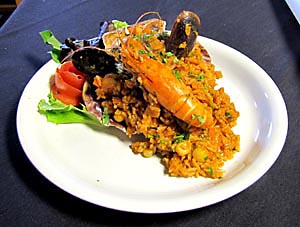 For many of Peru's inhabitants, these foodstocks allow for
adequate nutrition even though living standards are poor. The abandoning
of many of these staples during the Spanish domination and republican
eras has brought down nutritional levels in the country.
For many of Peru's inhabitants, these foodstocks allow for
adequate nutrition even though living standards are poor. The abandoning
of many of these staples during the Spanish domination and republican
eras has brought down nutritional levels in the country.
Some of these foodstocks have been used since 1985 by NASA for
astronaut food, like quinoa, kiwicha and maca.
Peruvian cuisine is often made spicy by means of ají pepper,
a basic ingredient. Some Peruvian chili peppers are not spicy but
serve to give taste and color to dishes. Rice often accompanies
dishes in Peruvian cuisine, and the regional sources of foods and
traditions give rise to countless varieties of preparation and dishes.
Fine Peruvian cuisine emphasizes the mix of colors and ingredients,
in a dynamically growing restaurateur industry and trends led by
young and talented chefs.
Cuisine of the Coast
Ceviche MixtoThe cuisine of the coast can be said to have five
strong influences: Japanese, the Moorish, the African, the Chinese
and the local native.
The Pacific Ocean is the principal source of aquatic resources
for Peru. Peru is one of the world's top two producers and exporters
of unusually high-protein fishmeal for use in livestock/aquaculture
feed. Its richness in fish and other aquatic life is enormous, and
many oceanic plant and animal species can only be found in Peru.
As important as the Pacific is to Peru's biodiversity, freshwater
biomes such as the Amazon River and Lake Titicaca also play a large
role in the ecological make-up of the country.
Every coastal region, being distinct in flora and fauna populations,
adapts its cuisine in accordance to the resources available in its
waters.
Ceviche, with its many different variations (pure, combination,
or mixed with fish and shellfish) is a good example of this regional
adaptation. Ceviche is found in almost all Peruvian restaurants
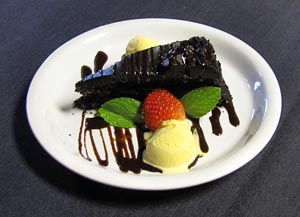 specialized in this country's world renowned fish and seafood.
Lima alone holds thousands of them, from the simple to very fancy
ones. Typically served with camote, or sweet potato.
specialized in this country's world renowned fish and seafood.
Lima alone holds thousands of them, from the simple to very fancy
ones. Typically served with camote, or sweet potato.
The chupe de camarones (shrimp cioppino) is one of the most popular
dishes of Peruvian coastal cuisine. It is made from a thick freshwater
shrimp (crayfish) stock soup, potatoes, milk and chili pepper. Regarded
as typical from Arequipa, Chupe de Camarones is regularly found
in Peruvian restaurants specialized in Arequipan cuisine.
|